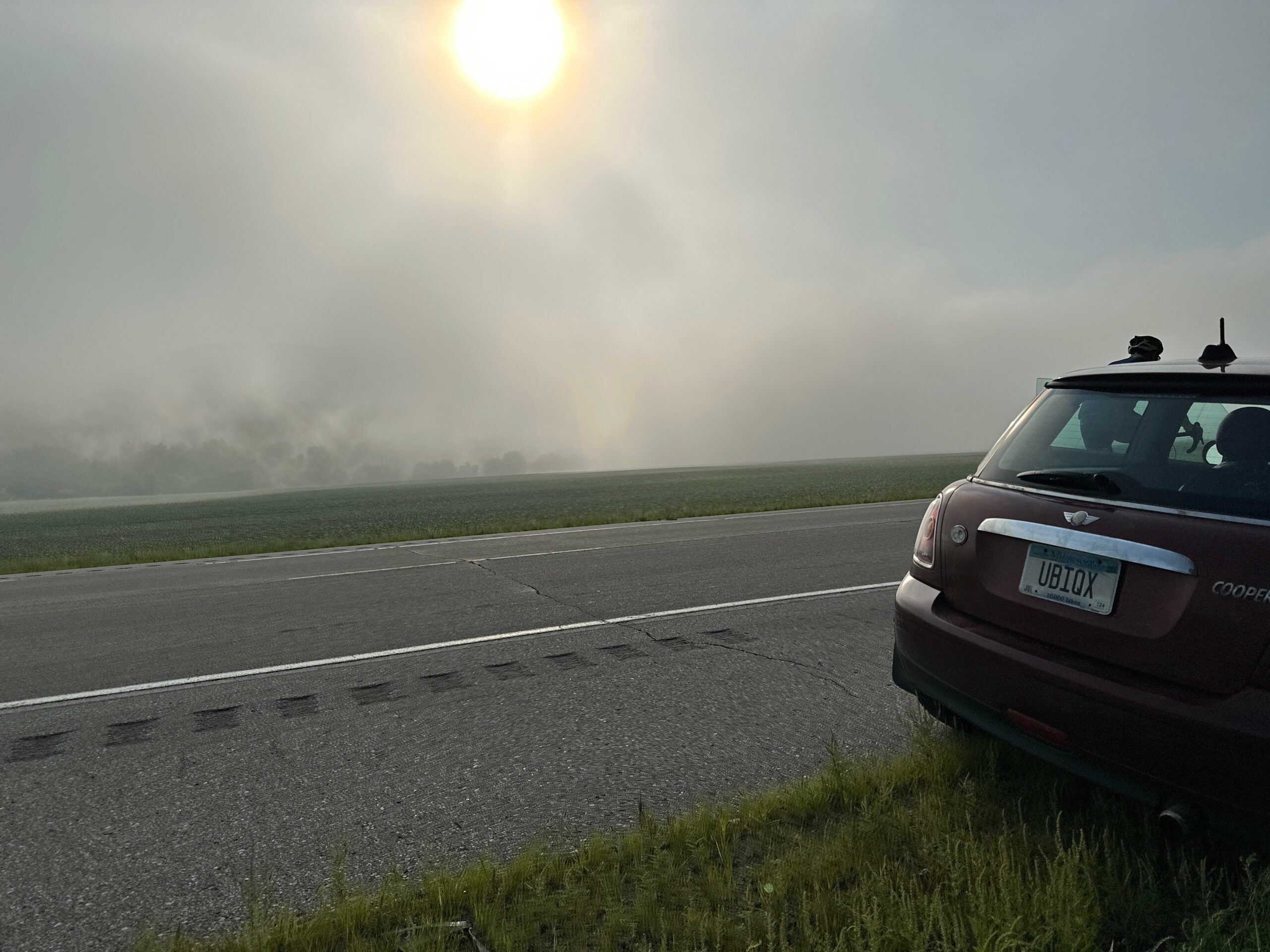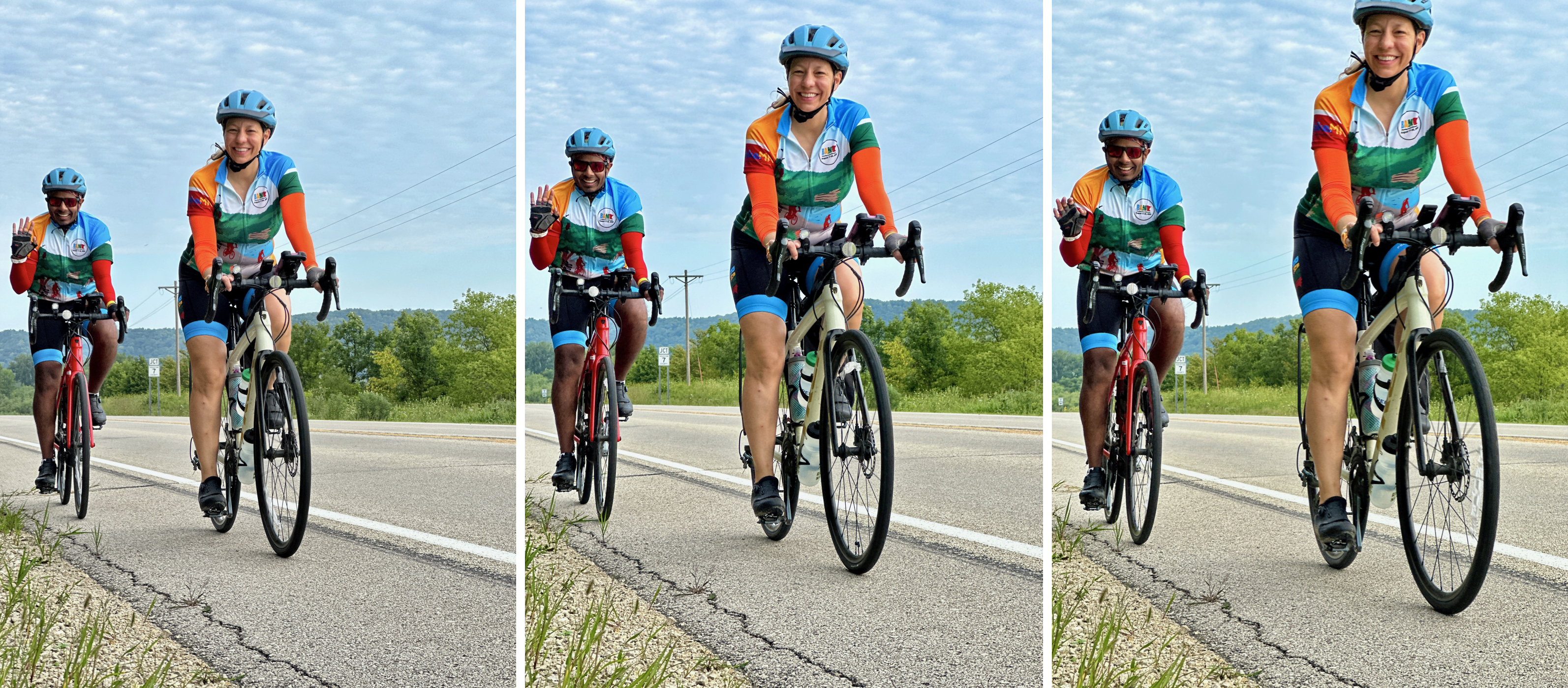About four years ago, at the pinnacle of my bicycling prowess, I embarked on the longest ride of my life—a 4-day, 253-mile tour of central Minnesota with my pal Chris and 300 other riders.
Painstakingly mapped out over the preceding months by Bicycling Around Minnesota (BAM), the 2019 trek was an exhilaratingly eccentric tour of rural and small-town America. Attractions along the route included Sinclair Lewis’ boyhood home, the MaxBat baseball bat factory, the Hemker Park & Zoo, the 1800s-vintage Forest City Stockade, the Darwin Twine Ball Museum, and, adjacent to the Lake Wobegon Trail in Collegeville, my St. John’s University alma mater with its Brutalist-style, visible-for-miles Abbey Church.
I took hundreds of photos with my iPhone Xs Max, repeatedly whipping it out of my jersey pocket to capture the sights. As an iPhone photographer, I border on the obsessive, and these were priceless opportunities.
But the BAM ride left me unsatisfied in another sense. I had wanted to capture the cycling action too, but I couldn’t do that safely while in motion, and I had limited time on rest breaks. Chris and I had a schedule to keep; I was a rider first and a photographer second.
A lot has happened to me since that ride: a blood infection soon after BAM that nearly did me in, COVID-19 restrictions that took BAM and other cycling events off my calendar, and a cycling-related concussion a year ago that triggered all manner of horrific symptoms and has prompted me to set my riding aside for now (see “Using Smart Speakers While Temporarily Blind,” 10 April 2023). As a result, I have recently felt unmoored and in need of excitement and purpose.
BAM came to my rescue last month. Chris had proposed I join the group’s first post-COVID ride in a non-cyclist capacity, so I volunteered to be the event’s semi-official photographer. Here, at last, was my chance to capture every facet of a BAM ride. And I would do it all with an iPhone—I haven’t owned an interchangeable-lens camera since the days of 35mm film.
I have snapped hundreds of thousands of iPhone shots since the device’s 2007 launch, but never in a role approximating that of a professional. I am no such pro, but impersonating one for a few days was a gas—and I got some pretty nice shots. I’ll let you decide whether they approach pro quality.
From the iPhone perspective, BAM is inconveniently timed, with current models on the verge of being displaced. Shortly after BAM 2023, Apple announced its “Wonderlust” media event for 12 September 2023, and the Internet is awash with rumors of new camera features like a “periscope lens” with a 5x, 6x, or even 10x optical zoom for the larger of the Pro models.
On this trip, I wasn’t exactly slumming it with my iPhone 14 Pro, though. And I had other tech along, including the recently released 15-inch MacBook Air. More on its utility in a bit, along with the tale of a road mishap just miles from BAM’s finish line that added some final excitement.
Zoom, Zoom
As we had done in 2019, in August, Chris and I journeyed in his beloved Mini Cooper to the BAM starting point. This year, the ride began and ended in Lanesboro with overnights in Rushford, La Crescent, and Houston, which are part of Minnesota’s gorgeous bluff country. Chris turned the Mini Cooper over to me for use on my photo rounds while he went on the ride. I would spend the next four days excitedly manual-shifting through the hilly land while glancing at the Ride with GPS bicycling app to keep pace with the pack of riders.
I kept my photo routine simple. Given the desire to shoot, edit, and post to BAM’s Facebook page quickly while on the move, I decided I would focus on still images. Perhaps I’ll dabble with slo-mo video next year.
I became a fixture by the side of roads, awkwardly crouching on the pavement or adjacent gravel or grass while aiming my iPhone at the oncoming riders. I wanted to get them at a slightly upward-pointing angle with an occasional bit of tilt.
The 3x optical zoom quickly became my new best friend, though it’s typically my least-used of the three iPhone Pro lenses. It just wasn’t possible to get close enough to fill the frame with riders without the zoom, and I wouldn’t turn up my nose at a 6x zoom if Apple were to add such a lens to the next iPhone.
Over and over, I’d channel Wayne Gretzky and aim my iPhone at the empty road just ahead of where cyclists would soon be, so they’d slide into my iPhone display. Sarah and Abhi enhanced the scene below by playfully pausing their pedaling and holding their poses.
One foggy morning, I pointed my iPhone across the road with the sun on the opposite side so riders would zoom in and out of view. I sought silhouettes and caught some good ones.
Another morning, I played up the weird clouds.
Camping at the overnight locations is half the BAM fun. Here’s that fog and the weird sky again.
Attractions along the way included Amish crafts and baked goods, fine wine at a vineyard on the Mississippi, a water-generated flour mill, and trailside sinkholes in Fountain, which bills itself as the Sinkhole Capital of the US (I can’t imagine there’s much competition). My favorite attraction photos are of Chris clowning around at a state-run fishery in Peterson and of young royals at a Spring Grove Soda Pop open house.
See more of my BAM 2023 photos.
Essential Tech for the Roving iPhone Photographer
I’m notorious in my family for packing far more tech gear on a trip than I need, and this one was no exception—but it is better to be over-equipped than at a loss in a pinch, am I right? Here’s a rundown of my critical kit.
15-inch MacBook Air
I debated whether to stay lean and forgo a laptop on the trip. The iPhone is as powerful as many computers, and it seems to be all the kids need these days to become social media influencers. Besides, I’d have a backup phone on the trip—an Android-based Samsung S21—so a notebook seemed like tech overkill, not to mention a physical burden.
But I happened to have a 15-inch MacBook Air on loan from Apple, and I couldn’t resist. The MacBook Air’s portability seduced me. This M2 model, released in June 2023 as the big brother to the 13-inch MacBook Air, may seem excessively large for a camping trip—but those are just the X and Y axes. It’s crazy thin at 0.44 inches (1.13 cm), the same as the 13-inch model, and only a bit heavier at 3.3 pounds (1.51 kg).
The Mac ended up going everywhere with me on the trip, tucked into my backpack, and I barely knew it was there. My iPhone got by far the most use during the day as I shot and posted batches of pictures to BAM’s Facebook page. But I’d stop the Mini Cooper now and then to unfold my camping chair and plop down in the shade for a bit of picture triaging.
I also pulled it out in the evenings after a meal and a visit to the shower trailer. Those were my moments of greatest happiness on the trip, luxuriating in the MacBook Air’s generously sized screen for powering through tasks that would have taken two or three times as long on a cramped iPhone display. The Apple silicon-powered machine stayed cool and quiet.
I would have regretted not packing the MacBook Air.
Backup Cellular Plan
I was wise to worry about cellular connectivity on the trip. US carriers have come a long way in bathing the hinterlands with high-speed bandwidth, but I still found myself in numerous dead spots during my travels.
As a precaution, I set myself up with a backup mobile plan at no cost. That’s a cinch since some cellular providers offer test drives with varying durations and data allocations. They install effortlessly on an iPhone via its eSIM capability.
T-Mobile was my first choice because its test drive lasts for a whopping 3 months or 30 GB of data, whichever comes first, but I could not get the eSIM installation to work, possibly because I tested T-Mobile in the past.
I ended up with the Verizon-powered Visible, which provides a 15-day test drive with what it says is unlimited data. I didn’t use the account enough to test that claim, but it did work nicely when my regular AT&T service didn’t provide coverage.
You can install additional eSIM accounts in a dormant state. I loaded Mint Mobile and Google Fi for double and triple backup but used neither. The Mint trial is ridiculously stingy at 7 days and 250 MB of data. Google Fi’s 7-day trial is unlimited (though throttled after 10 GB of data use), but its iPhone setup is absurdly fussy, and I never got around to finishing it.
EGO Nexus Power Station
Chris’s eyes bugged out when he saw what I wanted to pack for portable power. The EGO Nexus Power Station is a massive device requiring two handles to lug around. It sports four USB-A ports and three AC outlets, and gets its power from removable battery packs that slide into four slots on the side when you’re not using them to power EGO-branded lawnmowers, snow blowers, and other tools.
A screen on the Nexus Power Station was supposed to tell me how many hours of power I had left, but it never displayed the same number twice, with estimates jumping between 30 and 80 hours. That did not matter, however, because Chris and I got more than enough juice to charge our phones, portable battery packs, his bicycle computer, my Mac, and more multiple times throughout the trip. We could have recharged the battery packs by plugging the Nexus Power Station into a wall outlet, but that was never necessary.
I initially intended to haul the Nexus Power Station into my tent at night instead of leaving it in the Mini Cooper, fearing the device would get stolen. But it was such a hassle that I abandoned the plan after the first night.
The four-battery Nexus Power Station costs $1299, but you may find it overkill, as I did, and EGO seems to be phasing that model out. EGO also sells a two-pack model for $999. I probably could have gotten by with one of EGO’s smaller, more affordable inverters that work off a single power pack.
Adobe Photoshop Generative Fill
I never dreamed that the phrase “artificial intelligence” would appear in this article, but a kind of AI used for photo editing solved a thorny problem for me.
Remember the young royals? Here is how the photo of them originally looked. The woman in the yellow shirt spoils the shot.
Photo-editing tools such as Google’s Magic Eraser exist to excise unwanted elements from images, but all those I tried spoiled the picture further. Enter my TidBITS colleague Jeff Carlson, a photography expert who has dabbled with a pro-level tool called Generative Fill built into recent Photoshop betas.
Based on Firefly AI tech, Generative Fill gets its name from its scary-smart ability to conjure up imagery that is added to pictures. That can be as simple as extending a field or a forest beyond the borders of the original photograph or as wacky as placing a singing bison onto a Venetian gondola (hat tip to Jeff for the example).
You usually make or adjust images with text prompts describing what you’d like to see—the cloud-based AI tool generates the image based on what it has learned about similar scenes.
However, no text prompts were required in this case. Generative Fill flawlessly removed the pesky woman in two takes—upper torso first, and then her legs from under the table—and then seamlessly filled in what it believed the background should look like. Jeff explains:
I grabbed the Lasso tool, drew a round selection around the person in yellow, clicked the Generative Fill button in the floating toolbar that appears, then clicked the Generate button without typing anything into the field that would normally specify what you want to appear. With nothing in the field, it assumes you just want to remove whatever is selected.
So Close…
I was about 15 miles from the BAM finish line when, for about the 30th time, I pulled to the side of the road for rider shots.
This time, the Mini Cooper’s front right tire sank into an invisible patch of soft soil. No amount of revving and reversing got the car to move. Worse, it started to tilt sideways, and its back-left wheel rose off the pavement. Fearing the Mini would roll down the embankment, I had to exit frantically… and curse minutes later for forgetting to seize my iPhone. At least I had the Samsung phone in my pocket—this photo is the only time I used it on the trip.
A couple of my BAM colleagues enlisted a farmer with a tractor, but he was reluctant to pull on the front or the back of the Mini Cooper for fear of damaging body panels.
We finally summoned a tow truck driver who—in a maneuver I’d never seen—attached soft hooks to the front-left and back-left wheel axles and then slowly winched the car sideways to safety. It turns out I did shoot some iPhone video on this trip.
->Google Actualités




























